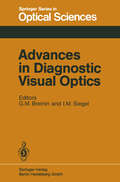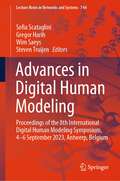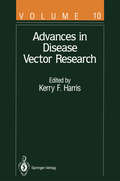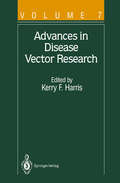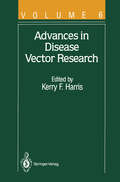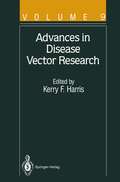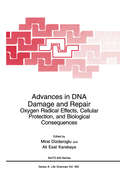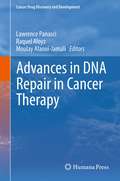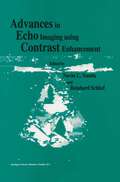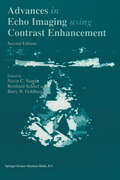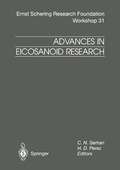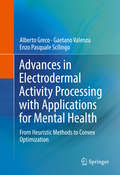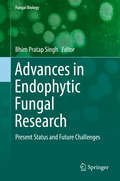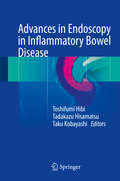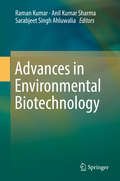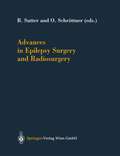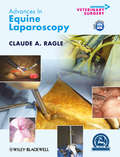- Table View
- List View
Advances in Diagnostic Visual Optics: Proceedings of the Second International Symposium, Tucson, Arizona, October 23–25, 1982 (Springer Series in Optical Sciences #41)
by G. M. Breinin I. M. SiegelOpening Remarks of the President, 2nd ISVO, Professor G.M. Breinin, M.D. The study of visual processes is surely unique as a clinical specialty, in corporating the disciplines of physics, chemistry, physiology, and psycho logy. Diagnosing and correcting disorders of the visual system in these last two decades of the 20th century has brought all of us into close prox imity with computer sciences, laser technology, the marvels of electronic microcircuitry, and the impressive developments in optical materials. Dur ing the course of this meeting we shall be hearing about how these different technologies can interact with one another, and we shall discover that such interaction may produce new diagnostic tools and new optical devices. We shall also learn that the optical qualities of the eye change during life, producing subtle and complex alterations in vision. On behalf of the members and organizing committee of the American Commit tee on Optics and Visual Physiology and our co-sponsoring organization, the Optical Society of America, I welcome you to this second symposium on visual optics. The first symposium took place in Japan in 1978 and, like the pres ent one, was a satellite meeting of the International Congress of Ophthal mology. The third symposium in this series will take place in Italy in 1986 as part of the next session of the International Congress of Ophthalmology.
Advances in Digital Forensics III: IFIP International Conference on Digital Forensics , National Center for Forensic Science, Orlando Florida, January 28-January 31, 2007 (IFIP Advances in Information and Communication Technology #242)
by Philip Craiger Sujeet ShenoiPractically every crime now involves some aspect of digital evidence. This is the most recent volume in the Advances in Digital Forensics series. It describes original research results and innovative applications in the emerging discipline of digital forensics. In addition, it highlights some of the major technical and legal issues related to digital evidence and electronic crime investigations.
Advances in Digital Human Modeling: Proceedings of the 8th International Digital Human Modeling Symposium, 4-6 September 2023, Antwerp, Belgium (Lecture Notes in Networks and Systems #744)
by Sofia Scataglini Gregor Harih Wim Saeys Steven TruijenThis book reports on advances in human modeling techniques, covering cutting-edge algorithms and their practical implementation in health and medicine, automotive, clothing, virtual reality simulations, robotics, and assistive technologies. Gathering the proceedings of the 8th International Digital Human Modeling Symposium, held on September 4-6, 2023, in Antwerp, Belgium, it offers a timely snapshot on interdisciplinary, applied research, at the interface between computer science, ergonomics, engineering, design, health and technologies.
Advances in Disease Vector Research (Advances in Disease Vector Research #10)
by El Desouky Ammar Y. Antignus T. R. Burkot E. P. Camargo Y. Chinzei S. Cohen D. Gonsalves P. M. Graves H. H. Hagedorn R. Hull E. I. Korenberg Yu. V. Kovalevskii G.W. Otim-Nape M. K. Shaw A. J. Shelley W. J. Tabachnick DeMar Taylor J. M. Thresh F. G. Wallace S. D. Yeh A. S. YoungVolume 10 of Advances in Disease Vector Research consists of seven chapters on vectors that affect human or animal health and six chapters on plant pathogens and their vectors. In Chapter 1, Yasuo Chinzei and DeMar Taylor discuss hormonal regulation of vitellogenesis in ticks. Many blood sucking insects and ticks transmit pathogens by engorgement, which induces vitellogenesis and oviposition in adult animals. To investigate the pathogen transmission mechanism in vector animals, information on the host physiological and endocrinological conditions after engorgement is useful and important because pathogen development or proliferation occurs in the vector hosts at the same time as the host reproduction. Chinzei and Taylor have shown that in ticks, juvenile hormone (JH) is not involved in the endocrinological processes inducing vitellogenin biosynthesis. Synganglion (tick brain) factor(s) (vitellogenesis inducing factor, VIF) is more important to initiate vitellogenesis after engorgement, and ecdysteroids are also related to induction of vitellogenin synthesis. In their chapter, based mainly on their own experimental data, the authors discuss the characterization of main yolk protein, vitellogenin (Vg) , biosynthesis and processing in the fat body, and hormonal regulation of Vg synthesis in tick systems, including ixodid and argasid ticks.
Advances in Disease Vector Research (Advances in Disease Vector Research #7)
by Christopher J. Andrews Richard H. Bagnall Nick Carter Claude Chastel John R. DeLoach Karen S. Gibb Richard Harrington Ian Humphery-Smith Ian Maudlin John W. Randles Ramesh C. Sinha George SpatesAdvances in Disease Vector Research (Advances in Disease Vector Research #6)
by S. Barbagallo M. R. Brown W. Burgdorfer F. H. Collins V. Finnerty D. A. Golino S. F. Hayes H. Hibino A. O. Lea G. P. Martelli J. Nedelman G. N. Oldfield S. M. Paskewitz R. T. Plumb A. H. Purcell B. Raccah C. N. Roistacher C. E. Taylor R. D. WardI think the reader will agree that we have attained a good balance in Volume 6 between human-or animal-host and plant-host-related topics from outstanding research scientists. In Chapter 1, Frank Collins, Susan Paskewitz, and Victoria Finnerty explore the potential of recombinant DNA technology to distinguish indi vidual species and to establish phylogenetic relationships among member species in the Anopheles gambiae species complex, which includes the principal malaria vectors. Currently, relatively little is known about these morphologically identical species that are sympatric over most of their range but are not always equally involved in malaria transmission. With respect to individual species identification, the researchers have thus far described two DNA fragments, derived from the ribosomal DNA interge nic spacer region, that reliably distinguish five species in the complex by means of an RFLP visualized on a Southern blot. They have also described other species-specific fragments derived from a ribosomal DNA intron that could form the basis for a rapid dot blot assay. With respect to the phylogenetic relationships among member species in the complex, Collins, Paskewitz, and Finnerty focus on a comparison at the level of restriction site mapping and Southern analysis of the rDNA intergenic spacer regions. As expected, the two spacer regions near the coding region junctions are well conserved among the species, whereas the central regions tend to be highly variable among member species in the complex.
Advances in Disease Vector Research: Volume 9 (Advances in Disease Vector Research #9)
by J. J. Cho D. M. Custer T. L. German R. Gothe U. B. Gunashinghe P. J. Ham W. B. Hunter M. Klein W. J. Kloft R.F.L. Mau R. G. Milne G. I. Mink A. S. Raikhel J. Richardson E. S. Sylvester D. E. Ullman D. M. WestcotVolume 9 in this series consists of four chapters on vectors that affect human or animal health and six chapters on plant pathogens and their vectors. In Chapter 1, Alex S. Raikhel discusses vitellogenesis in mosquitoes: the cornerstone of the reproductive cycle involving massive production of yolk precursors by the fat body and their accumulation in developing oocytes. In anautogeneous mosquitoes, vitellogenesis is dependent on the availability of a blood meal and, as a consequence, is linked to transmission of pathogens. Therefore, elucidation of mechanisms governing the mosquito vitellogenesis is critical for the successful development of novel strategies in vector and disease management. Previous reviews on mosquito vitellogenesis have dealt predominantly with hormonal control. The goal of this review, however, is to summarize significant progress which has been achieved in understanding mosquito vitellogenesis at the cellular, biochemical and molecular levels. It is with these disciplines that we expect to fully understand the mechanisms governing this key process in mosquito reproduction.
Advances in DNA Damage and Repair: Oxygen Radical Effects, Cellular Protection, and Biological Consequences (Nato Science Series A: #302)
by Miral Dizdaroglu Ali Esat KarakayaIn recent years the field of DNA repair has flourished due to new findings on DNA repair mechanisms and the molecular basis of cancer. This volume covers the most recent developments in this research field and contains contributions from scientists working in various fields.
Advances in DNA Repair in Cancer Therapy (Cancer Drug Discovery and Development #72)
by Lawrence Panasci, Raquel Aloyz and Moulay Alaoui-JamaliA comprehensive review of the recent developments in DNA repair research that have potential for translational applications. The book explains in detail the various biological mechanisms by which cancer cells can circumvent anticancer therapy and limits its usefulness in patients. They also review the impact of such novel inhibitors of DNA repair mechanisms as methylguanine-DNA-methyltransferase. Also examined are inhibitors of other DNA repair enzymes such as PARP and DNA-PK. The book captures-for both cancer researchers and oncologists dealing with hallmark "relapse" or "drug resistance" phenomena on a daily basis-the many exciting new uses of DNA repair inhibitors, either alone or in combination with anticancer therapies.
Advances in Down Syndrome Research (Journal of Neural Transmission. Supplementa #67)
by G. Lubec"Advances in Down Syndrome Research” represents updated research in several areas of Down Syndrome (DS). A new promising animal model of DS is reported and this opens new opportunities to study pathomechanisms and pharmacological approaches as it is more than difficult to carry out studies in humans and the clinical features are highly variable. In terms of biology, cell cycle and stem cell studies and in terms of biochemistry, relevance of studies on a specific protein kinase, channels, transporters, superoxide dismutase, antioxidant system, chromosome assembly factor and other important biological structures are provided. And again, the gene dosage hypothesis is addressed and although the vast majority of chromosome 21 gene products is unchanged in fetal DS brain, a few specific chromosome 21 encoded structures including transcription factors are indeed overexpressed although findings in fetal DS are different from those in adult DS brain when Alzheimer-like neuropathology supervenes.
Advances in Echo Imaging Using Contrast Enhancement
by N. C. Nanda Reinhard Schlief B. B. GoldbergThe first edition of this definitive text ran to 24 chapters. The second edition, reflecting the explosive growth of interest in echo-enhancement, contains 44. The first section deals with some of the most important emerging issues and technologies and covers harmonic imaging, the use of echo-enhancers to provide quantitative information, and the application of enhanced power Doppler to tissue imaging. The second, on contrast echocardiography, explores the use of echo-enhancement during transesophageal imaging. One chapter describes the use of contrast-enhancement transesophageal imaging to determine coronary flow reserve and another gives a detailed account of the application of the technique to the evaluation of left ventricular function. Other authors describe the intraoperative use of contrast echocardiography and discuss the potential of myocardial contrast echocardiography to replace thallium scintigraphy. Another chapter covers the emerging technique of transient response imaging and its role in the assessment of myocardial perfusion, and two chapters are devoted to three-dimensional contrast echocardiographic assessment of myocardial perfusion. Use of echo-enhancement in the evaluation of peripheral circulation is discussed in chapters on carotid and peripheral arterial flow imaging and others that describe renal and hepatic vascular imaging. The newer applications of echo-enhancement outside the cardiovascular system are described in three chapters devoted to the visualization of tumour vasculature. The final chapters look to the future and cover the imaging of intramyocardial vasculature, the development of site-specific agents and the emergence of the new acoustically active agents.
Advances in Eicosanoid Research (Ernst Schering Foundation Symposium Proceedings #31)
by H. D. Perez C. N. SerhanOver the last few years, we have witnessed tremendous progress in the field of eicosanoids and their therapeutic applications. Receptor an tagonists for leukotrienes have been tested as anti-inflammatories and are on the market as a treatment for asthma. Receptor agonists for pro stacyclin are being tested for the treatment of peripheral vascular dis ease, and selective inhibitors of cyclooxygenase type II were just ap proved for the treatment of rheumatoid arthritis. All these developments are the culmination of many years and man-hours of careful research. The field has now entered an upswing that will result in novel thera peutic applications within the next 10 years. New molecules and me diators have been identified, new enzymes and pathways elucidated and new therapeutic approaches have emerged. The concept of ei cosanoids as "pro-inflammatory" molecules is being challenged, and their role as regulators is increasingly recognized. In fact, some of these molecules may be important endogenous anti-inflammatory agents.
Advances in Elder Abuse Research: Practice, Legislation and Policy (International Perspectives on Aging #24)
by Amanda PhelanThis book provides an insight into advances in elder abuse in the areas of research, policy, practice and legislation. It provides readers with a broad understanding of the topic and considers the progress in elder abuse knowledge. The book explores the nexus of ageism and elder abuse, describes key social policies and their legislative manifestation, covers major policies and programs related to elder abuse, defines elder sexual abuse and much more. It offers the reader a comprehensive insight into new perspectives and approaches to both understanding and responding to elder abuse. As such it will be an asset to academics, students, healthcare practitioners, policy makers and the general public.
Advances in Electrodermal Activity Processing with Applications for Mental Health: From Heuristic Methods to Convex Optimization
by Alberto Greco Gaetano Valenza Enzo Pasquale ScilingoThis book explores Autonomic Nervous System (ANS) dynamics as investigated through Electrodermal Activity (EDA) processing. It presents groundbreaking research in the technical field of biomedical engineering, especially biomedical signal processing, as well as clinical fields of psychometrics, affective computing, and psychological assessment. This volume describes some of the most complete, effective, and personalized methodologies for extracting data from a non-stationary, nonlinear EDA signal in order to characterize the affective and emotional state of a human subject. These methodologies are underscored by discussion of real-world applications in mood assessment. The text also examines the physiological bases of emotion recognition through noninvasive monitoring of the autonomic nervous system. This is an ideal book for biomedical engineers, physiologists, neuroscientists, engineers, applied mathmeticians, psychiatric and psychological clinicians, and graduate students in these fields.This book also: Expertly introduces a novel approach for EDA analysis based on convex optimization and sparsity, a topic of rapidly increasing interest Authoritatively presents groundbreaking research achieved using EDA as an exemplary biomarker of ANS dynamicsDeftly explores EDA's potential as a source of reliable and effective markers for the assessment of emotional responses in healthy subjects, as well as for the recognition of pathological mood states in bipolar patients
Advances in Electromagnetic Fields in Living Systems: Volume 4 (Advances in Electromagnetic Fields in Living Systems #1)
by James C. LinHardly any phenomenon in the modern environment is as ubiquitous as electromagnetic fields and waves. We have learned to understand the physical characteristics of these energy forms, and we have applied them in abundant ways to embellish our ways of life and our standards of living. Furthermore, we have come to depend on them for health, safety, information, comfOli, and conveyance. Apart from their intended roles, these electromagnetic fields and waves produce other effects which may influence the activities of living organisms. The effects produced depend on many physical, chemical, and biological factors. They may be grossly apparent and visible soon after exposure of the living organism or they may not appear to have influenced the organism at all upon casual examination. Even then, there may be subtle changes which are only detectable upon careful chemical or microscopic study, or which are apparent only after a considerable time delay. Nevertheless, our understanding of the interaction of electromagnetic fields with living systems is advancing in a wide range of topical areas. This bi-annual series with invited reviews by recognized leaders in their respective specialties, will present progress to date in key areas of research and scholarship. The guiding philosophy of this undertaking is the presentation of integrated, known, and confilmed phenomenological observations, basic mechanism of interactions, and applications in biology and medicine, as well as perspectives on current topics of interest.
Advances in Electromagnetic Fields in Living Systems (Advances in Electromagnetic Fields in Living Systems #3)
by James C. LinThis is the third volume in the series, in which the topic of the effects of radio frequencies on human tissue, now increasingly a concern with the prevalence of cell phones, is explored by Prof. Lin and other researchers. The impact of electromagnetics on imaging and cardiology, both very keen areas of research at present, is also explored.
Advances in Electromagnetic Fields in Living Systems: Volume 4 (Advances in Electromagnetic Fields in Living Systems #4)
by James C. LinThis comprehensive and topical volume presents a number of significant advances on many fronts in this area of research, particularly emphasizing current and future biomedical applications of electromagnetic fields.
Advances in Electromagnetic Fields in Living Systems: Volume 5, Health Effects of Cell Phone Radiation (Advances in Electromagnetic Fields in Living Systems #5)
by James C. LinHealth Effects of Cell Phone Radiation will offer a concentrated and up-to-date overview on the effects of radio frequencies on human tissue. While significant advances are being made on many fronts, ranging in frequency from quasi-static to the optical regime, a special emphasis of this volume is on current understanding of biological interactions of cellular mobile communication radiation. The use of cell-phones has experienced phenomenal growth - some estimate that there will be more than 3.5 billion users of these wireless devices by the end of 2010, worldwide. The widespread impact of these new wireless technologies has raised concerns about the safety of human exposure to radio-frequency (RF) energy emitted by these telecommunication devices. A better understanding of the biological effects of RF electromagnetic field is needed to safeguard against possible harm to the general population. Fortunately in recent years there has been a resurgence of research interest in achieving a quantitative understanding of the relationships between the biological effects of RF radiation and the physical variables that may cause them. A significant number of results have and are beginning to appear in the literature. This volume reviews and assesses the biological effects of exposure to electromagnetic fields from wireless communication technology.
Advances in Endophytic Fungal Research: Present Status and Future Challenges (Fungal Biology)
by Bhim Pratap SinghPlant endophytes are a potential source for the production of bioactive compounds that can fight against devastating diseases in both plants and humans. Among these endophytic microorganisms, endophytic fungi are one of the dominant group of microorganisms with a potential role in plant growth promotion and the discovery of noble bioactive natural products. Endophytic fungi possess several bioactivities like anticancer, antimicrobial, insecticidal, plant growth stimulants, crop protection, phytoremediation, etc. Presence of modular biosynthetic genes clusters like PKS and NRPS in several endophytic fungi underscores the need to understand and explore such organisms. This volume presents and demonstrates the applied aspects of endophytic fungi. Practical applications of such endophytes are discussed in detail, including studies in pharmaceutical development and agricultural management of important microbial diseases. The beneficial effects that endophytic fungi provide to host plants—enhancing growth, increasing fitness, strengthening tolerance to abiotic and biotic stresses through secondary metabolites—are also discussed. The reader is provided with a comprehensive and detailed understanding of such relationships between endophytic fungi and their host.
Advances in Endoscopy in Inflammatory Bowel Disease
by Toshifumi Hibi Tadakazu Hisamatsu Taku KobayashiAdvances in Endoscopy in Inflammatory Bowel Disease summarizes the recent progress made in endoscopy, an essential tool for the diagnosis and management of IBD. It goes on to provide an introduction of state-of-the-art endoscopic techniques, as well as an atlas of high-quality endoscopic images of IBD and related diseases. Among others, endoscopy is one of the clinical fields in which Asian countries are leading the way in the management of gastrointestinal disorders. As the number of patients with IBD is dramatically increasing in Asia, quality of patient care has been significantly improved. With diagnosis of intestinal Behcet, simple ulcers, and intestinal tuberculosis, which are unique to the Asian countries, this book offers the ideal standard textbook for IBD endoscopy in all Asian counties, while the superior quality of images also makes it a valuable resource for practitioners around the globe. This book will significantly help all physicians, endoscopists and researchers working on GI endoscopy, especially those focusing on IBD, to improve their knowledge of IBD endoscopy.
Advances in Environmental Biotechnology
by Raman Kumar Anil Kumar Sharma Sarabjeet Singh AhluwaliaThe book aims to provide a comprehensive view of advanced environmental approaches for wastewater treatment, heavy metal removal, pesticide degradation, dye removal, waste management, microbial transformation of environmental contaminants etc.With advancements in the area of Environmental Biotechnology, researchers are looking for the new opportunities to improve quality standards and environment. Recent technologies have given impetus to the possibility of using renewable raw materials as a potential source of energy. Cost intensive and eco-friendly technology for producing high quality products and efficient ways to recycle waste to minimize environmental pollution is the need of hour. The use of bioremediation technologies through microbial communities is another viable option to remediate environmental pollutants, such as heavy metals, pesticides and dyes etc. Since physico-chemical technologies employed in the past have many potential drawbacks including higher cost, and lower sustainability. So there is need of efficient biotechnological alternatives to overcome increasing environmental pollution. Hence, there is a need for environmental friendly technologies that can reduce the pollutants causing adverse hazards on humans and surrounding environment.
Advances in Epilepsy Surgery and Radiosurgery (Acta Neurochirurgica Supplement #84)
by O. Schröttner B. SutterWashington D. C. , and at the Columbia University New York. In 1967 and 1968 he worked as a gen eral surgeon at the 1st Surgical Department of the Vienna Medical School with Professor Fuchsig. At the Max-Planck Institute in Munich he worked in the years 1968 to 1969 as a neuropathologist. In the year 1969 till 1972 back at the Department of Neurosurgery in Vienna he served as a general neurosurgeon and one of his main goals was pediatric neurosurgery. In Au gust 1972 he moved to Kiel to work with Professor Jensen at the Neurosurgical University Hospital. He had to graduate one more time in Germany and he did this with "Ultrasound Tomography in Neurosurgery". Together with the Department of Pediatrics he started to build the Pediatric Neurosurgical Department. At this time he started his research on pineal, midbrain and brainstem surgery. In September 1976 he started at the Ostsee Clinic Damp in Schleswig-Holstein to build a Neurosurgical Department that opened its gates on 1977 and he became the first chairman. On On September 30th, 2002 Professor Gerhard Pendl, April 1, 1978 he went back to Vienna as the Vice M. D. retires from his chairmanship at the Department Chairman of the Department of Neurosurgery at the of Neurosurgery at the University Hospital in Graz. University Hospital in Vienna under Professor Koos Shortly after his birth on July 10, 1934 in Linz and in 1980 he got his Ph. D.
Advances in Equine Laparoscopy (AVS Advances in Veterinary Surgery #3)
by Claude RaglePart of the Advances in Veterinary Surgery series copublished with the ACVS Foundation and Wiley-Blackwell, Advances in Equine Laparoscopy presents a state-of-the-art reference on laparoscopic skills and procedures in the horse. Chapters are written by the leading experts in the field, and each section includes a practical review of the published literature. Encompassing instrumentation, basic principles, and specific techniques, Advances in Equine Laparoscopy offers an up-to-date, reliable resource for comprehensive information about equine laparoscopy. This current, well-referenced text begins with a section on the fundamentals of laparoscopy, then moves into sections on the clinical application of laparoscopic techniques in the standing or recumbent horse. A companion website offers eight video clips demonstrating selected procedures at www.wiley.com/go/ragle. Advances in Equine Laparoscopy is an invaluable guide for equine surgical specialists and equine clinicians interested in laparoscopic techniques.
Advances in Equine Laparoscopy (AVS Advances in Veterinary Surgery)
by Claude A. RaglePart of the Advances in Veterinary Surgery series copublished with the ACVS Foundation and Wiley-Blackwell, Advances in Equine Laparoscopy presents a state-of-the-art reference on laparoscopic skills and procedures in the horse. Chapters are written by the leading experts in the field, and each section includes a practical review of the published literature. Encompassing instrumentation, basic principles, and specific techniques, Advances in Equine Laparoscopy offers an up-to-date, reliable resource for comprehensive information about equine laparoscopy. This current, well-referenced text begins with a section on the fundamentals of laparoscopy, then moves into sections on the clinical application of laparoscopic techniques in the standing or recumbent horse. A companion website offers eight video clips demonstrating selected procedures at www.wiley.com/go/ragle. Advances in Equine Laparoscopy is an invaluable guide for equine surgical specialists and equine clinicians interested in laparoscopic techniques.
